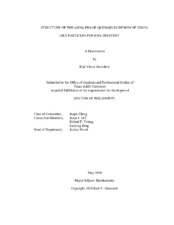| dc.description.abstract | Single-stranded (ss) RNA viruses infect all domains of life. Qβ, an ssRNA phage specific for Escherichia coli, has a near T=3 icosahedral lattice of coat proteins assembled around the genomic RNA (gRNA). In this work, the structure of the ssRNA virus Qβ was solved using cryo-electron microscopy, including the gRNA within the capsid. In ssRNA phages there is a well-established form of translational regulation wherein the coat protein binds specifically to a stem-loop at the start of the replicase. This stem-loop is thought to be important as a nucleation site to start the assembly of these phages. When looking for this site within the electron density, there were many which fit the previous crystal structure. This result led to the hypothesis that significant portions of the genome can be replaced and the virus can still assemble. The region encoding the coat protein was replaced with GFP or a kanamycin resistance gene, with the coat protein supplied in trans. The ‘virus-like’ particles were able to ‘infect’ cells to deliver their cargo, seen through fluorescence or bacteria resistant to kanamycin. The previously determined secondary structure of the gRNA was modeled into and largely fit the electron density of Qβ. Site-directed mutagenesis and plaque assays were used to validate the gRNA / maturation protein contacts. The mutated viruses were subsequently purified to verify that the coat proteins assembled into a capsid. During the establishment of a new purification procedure, new capsid morphologies were discovered, and subsequently verified by purifying the wild-type virus in the same manner as the non-infectious and thus poorly expressed mutants. The new capsid morphologies were probably lost in previous purification techniques, as they have a different density due to the ratio of encapsidated RNA to proteins in the capsid. These capsid morphologies have never been seen for a wild-type ssRNA phage. For the smaller capsid, the volume is too small for the full-length genome, so the RNA inside is either degraded viral gRNA or host RNAs. In sum, this work proposes and validates guidelines for packaging foreign RNAs and their delivery into piliated bacteria using VLPs based off of ssRNA phages. | en |


